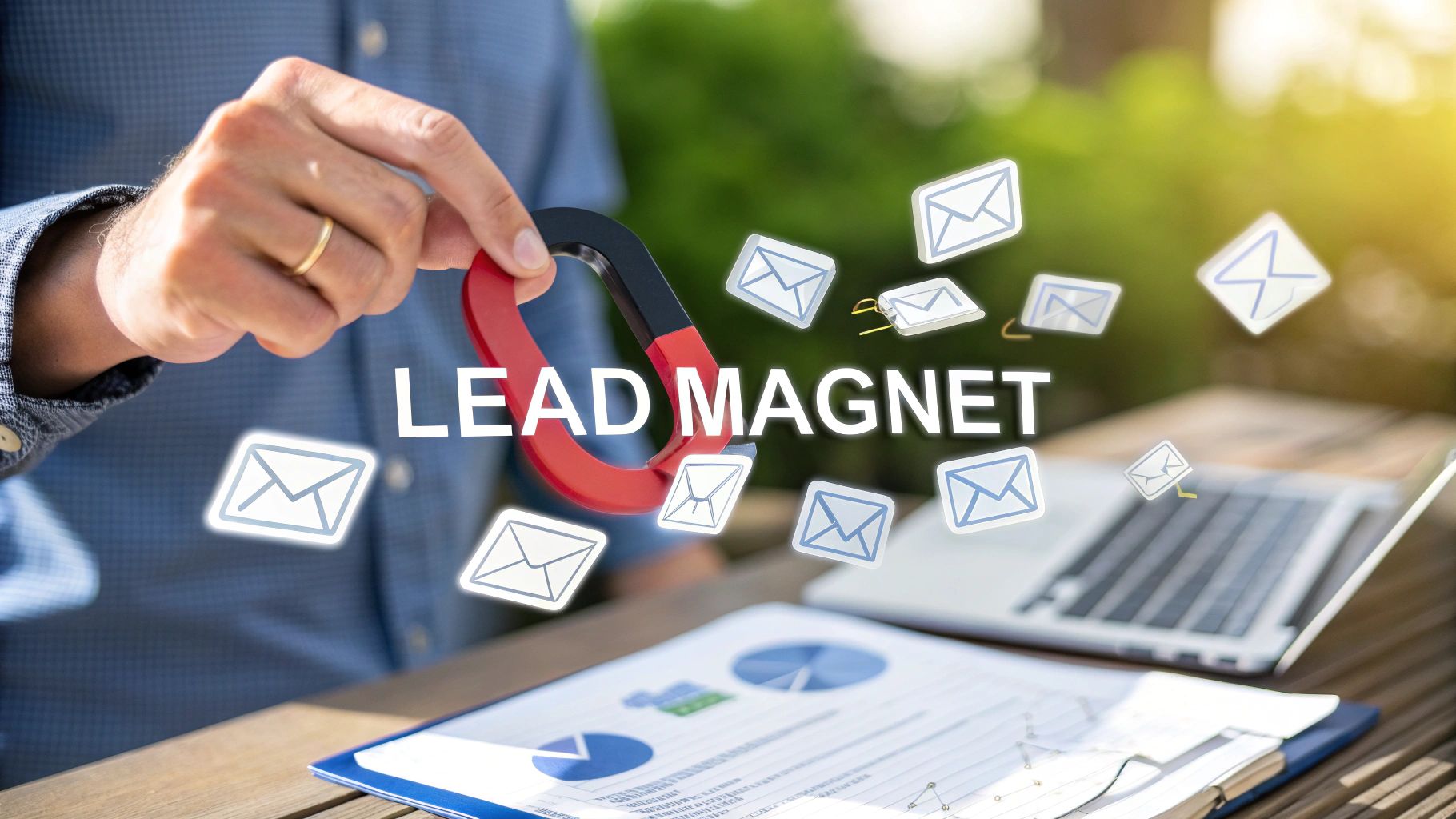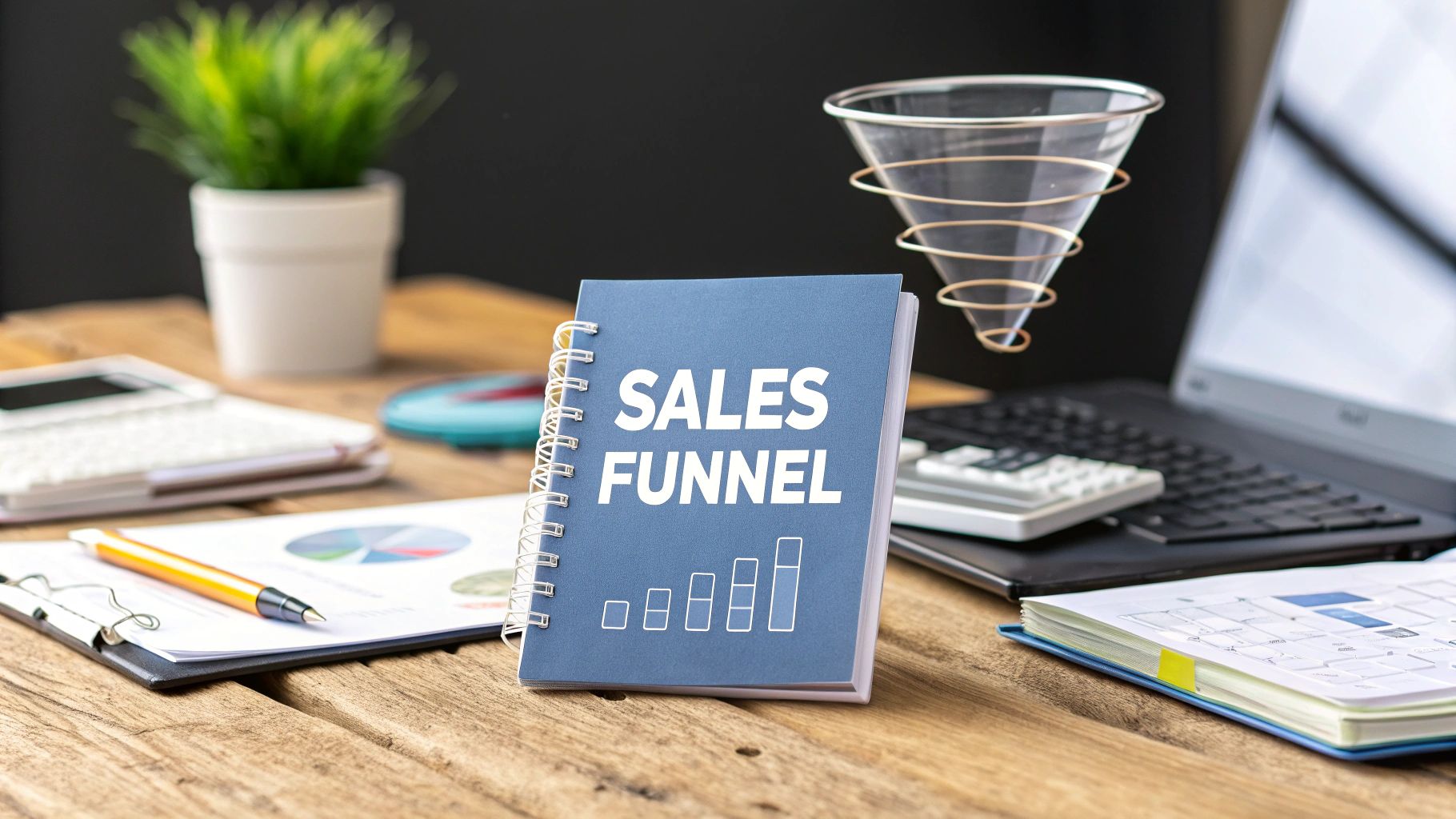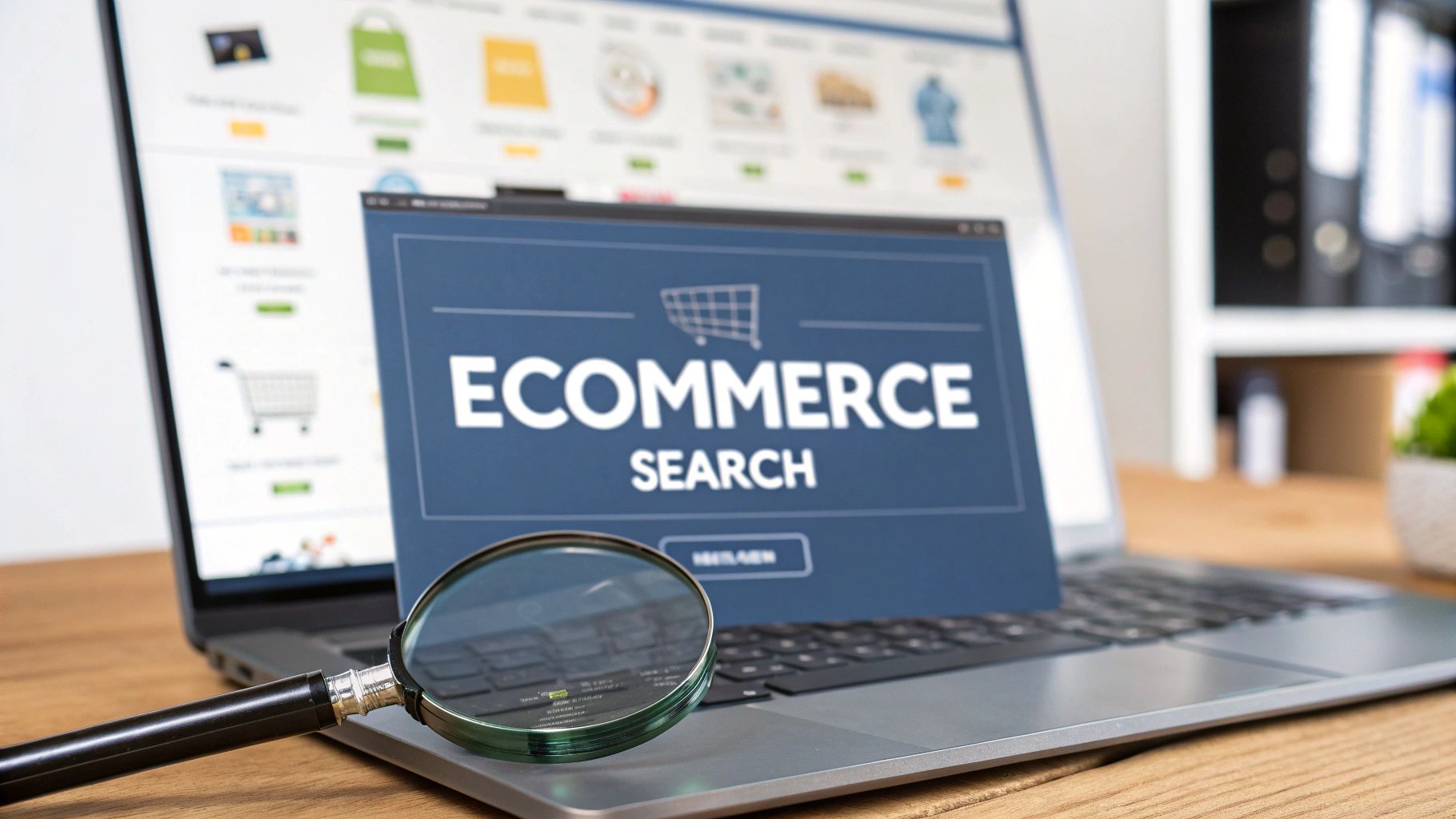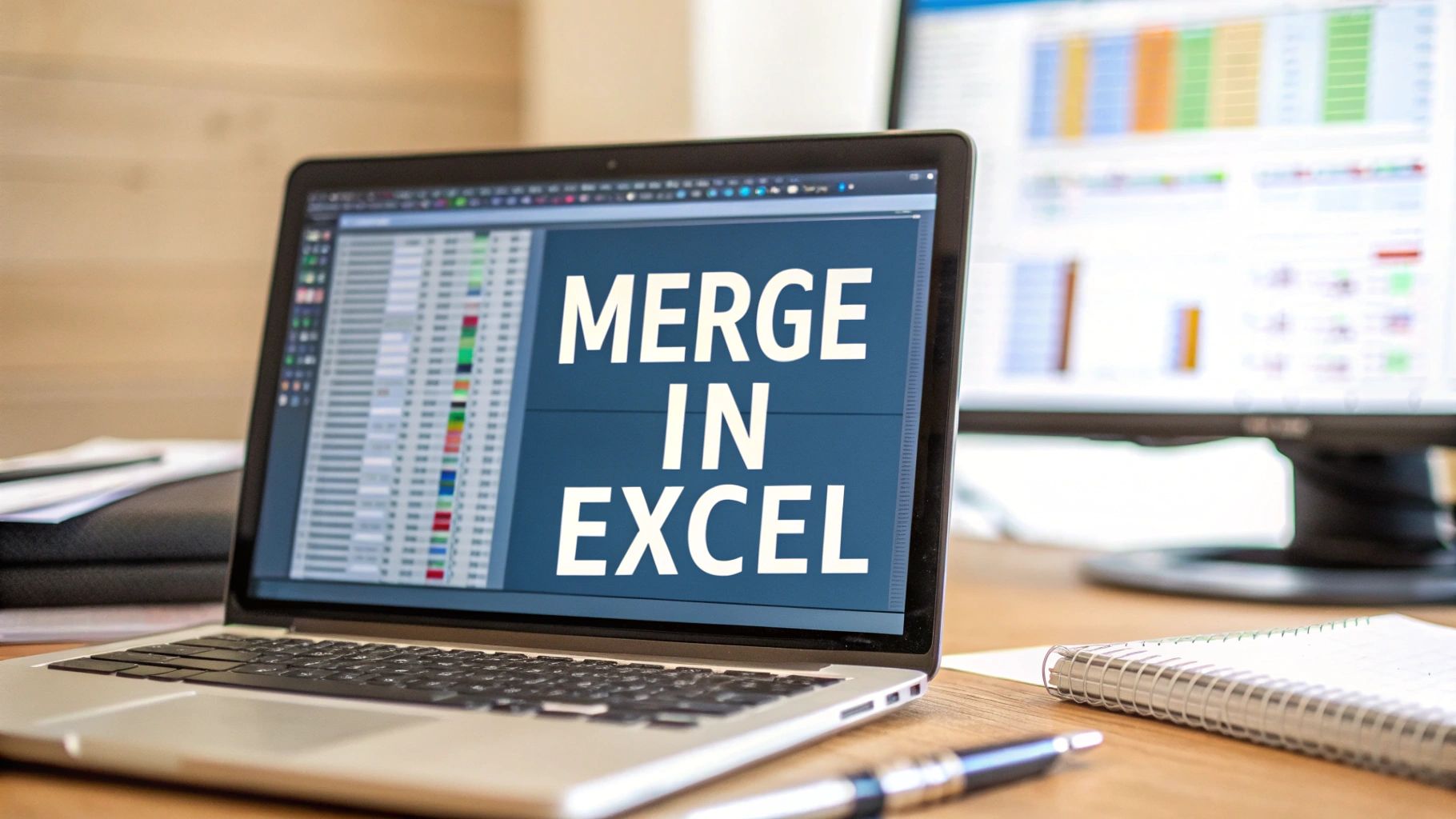A Winning Local Marketing Strategy for Your Business

A local marketing strategy is your playbook for winning customers right in your own backyard—think your neighborhood, your city, your service area. It's not about casting a massive, expensive net online. Instead, it's about using laser-focused tactics like local SEO, community events, and geo-targeted ads to connect with people who are close enough to become your best, most loyal customers.
Why Local Marketing Is Your Greatest Advantage
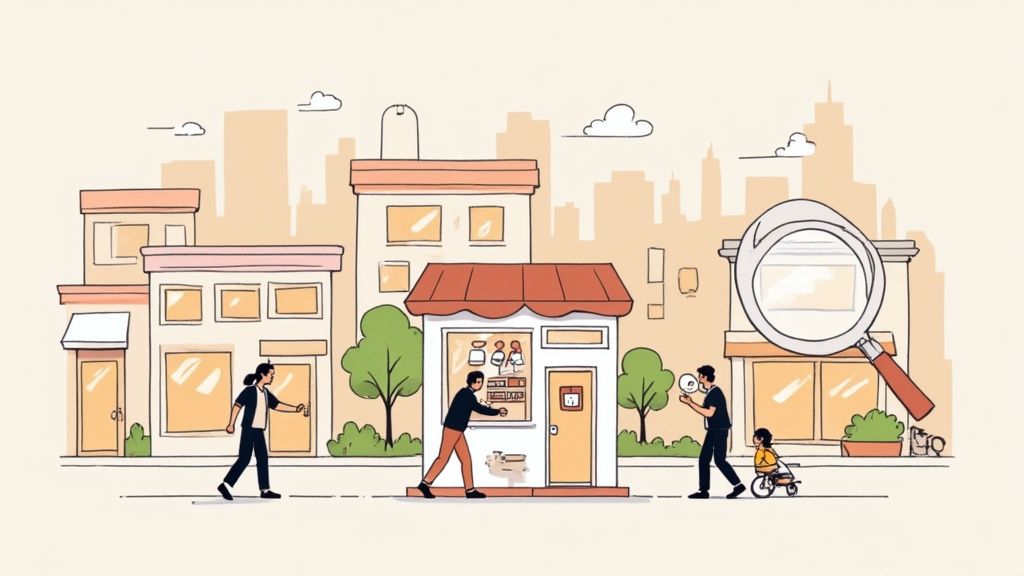
In a world overflowing with global brands and faceless online stores, your biggest strength might just be right outside your front door. A dedicated local marketing strategy isn't just for brick-and-mortar shops anymore; it's a game-changer for any business that wants to truly own its neighborhood.
This isn't about generic advertising. It’s about building real, tangible connections and becoming a recognized, trusted part of the community you serve. The whole idea is simple: focus your time, energy, and budget on the people who can actually walk through your door, use your services, and tell their friends about you.
The Power of Proximity
Think about your own habits. When you need something, what’s the first thing you do? You probably pull out your phone and search for "coffee near me" or "best plumber in [your city]." This is second nature for modern consumers. They expect instant, relevant results that solve a problem right where they are, right now.
By building your marketing around this behavior, you put your business directly in front of them at the exact moment they're ready to buy. This isn't just a theory; the data paints a crystal-clear picture. A stunning 94% of high-performing brands have a dedicated local marketing strategy, compared to just 60% of average ones. As competition gets fiercer, a dialed-in local plan is what separates the winners from the rest.
A winning local strategy isn't about outspending the national giants. It’s about out-connecting them. You can't beat genuine community engagement, perfect local SEO, and hyper-relevant offers. That's your home-field advantage.
Before we dive into the step-by-step playbook, let's get a high-level view of the core components that make a local strategy click.
Core Pillars of a Local Marketing Strategy
A strong local marketing plan isn't just one thing; it's a few key pillars working together to create a powerful, self-reinforcing system. Here’s a quick breakdown of what those pillars are and what they aim to achieve.
| Pillar | Key Objective | Primary Tools |
|---|---|---|
| Local SEO & Digital Presence | Dominate local search results and be easily found online. | Google Business Profile, Local Citations, Customer Reviews |
| Community & Partnerships | Build trust and real-world relationships with your audience. | Local Events, Sponsorships, Business Collaborations |
| Targeted Local Advertising | Reach potential customers in a specific geographic area efficiently. | Geo-targeted PPC Ads, Social Media Location Targeting |
These pillars are the foundation of everything we'll cover. For businesses in specific industries, like hospitality, you can see how these concepts are adapted in our deep dive on specializing in restaurant marketing.
Here’s a closer look at how these pillars come to life:
- Local SEO & Digital Presence: Think of this as your digital storefront. It's all about making sure that when someone searches for what you offer, you pop up first—especially on Google Maps. This means an optimized Google Business Profile, consistent business info across the web, and a steady stream of glowing reviews are non-negotiable.
- Community Engagement & Partnerships: This is where you build genuine goodwill. It’s about sponsoring the local little league team, partnering with a neighboring business for a joint promotion, or hosting a small workshop. These actions create an authentic connection that no amount of ad spend can replicate.
- Targeted Local Advertising: This is where you put your ad budget to work—smartly. Instead of blasting ads to everyone, you use geo-targeting on platforms like Google and Facebook to reach people within a specific radius of your business. Every dollar goes further because it's aimed at someone who can actually become a customer.
When you get these three areas right, they feed into each other. Your top-notch SEO helps people find you online, your community involvement builds their trust, and your targeted ads capture their immediate interest. It's a powerful combination.
Optimizing Your Digital Storefront with Local SEO
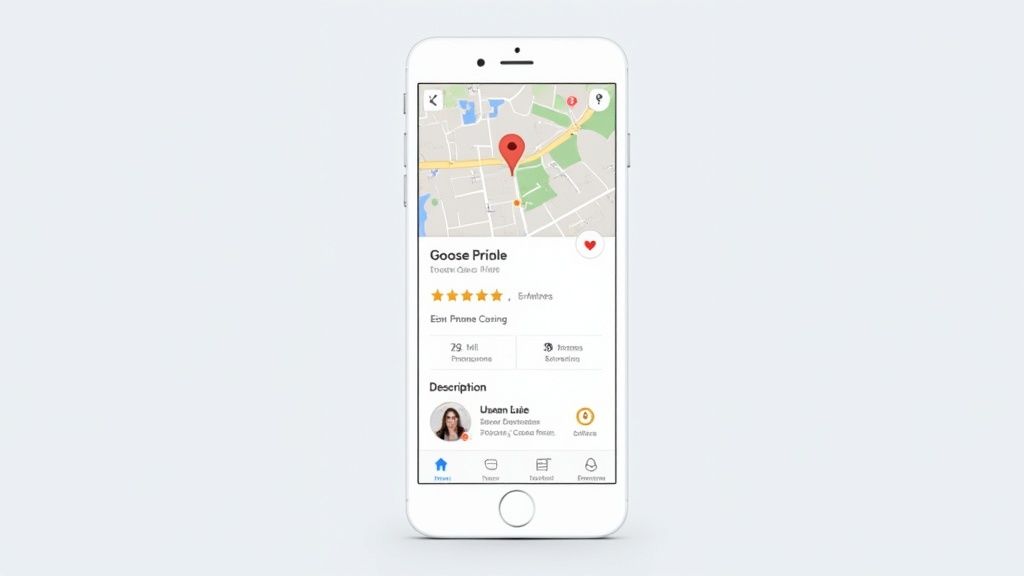
Alright, you get why a local focus is your biggest advantage. Now it's time to build your digital headquarters. In local marketing, your most valuable piece of real estate isn't a physical storefront—it's your Google Business Profile (GBP). This free listing is the modern front door to your business, and it’s often the very first interaction a potential customer will have with your brand.
Getting this right is non-negotiable.
When someone searches for "best tacos near me" or "emergency plumber in [your city]," Google's "Local Pack" is the holy grail. That’s the map with three business listings staring back at you from the top of the search results. A fully optimized GBP is your ticket to getting featured there, driving both clicks and actual foot traffic.
The numbers here are staggering. There are 97 billion local searches happening online every single month. Those searches lead to roughly 1.5 billion visits to physical locations monthly, drawing a straight line between online discovery and offline sales. Businesses that go all-in on their GBP—especially those with over 100 images—see up to 1065% more clicks than the ones with bare-bones profiles.
Claiming and Fortifying Your GBP
First things first: you need to claim and verify your profile. This part is simple but absolutely critical. Head over to the Google Business Profile manager, find your business, and follow the verification steps. Usually, this means Google will mail a postcard with a code to your physical address to prove you're a real, local operation.
Once you’re verified, the real work begins. Don't just fill out the basics; treat every single section as a chance to win over a customer.
- Business Name: Use your actual business name. Seriously. Resist the urge to stuff keywords in there (e.g., "Joe's Plumbing - Best Plumber in Springfield"). That's an old-school tactic that can get your profile penalized today.
- Categories: This is how you tell Google exactly what you do. Choose a primary category that best fits your main service, then add secondary categories for everything else you offer. A bakery might pick "Bakery" as its primary, but also add "Cafe," "Coffee Shop," and "Dessert Shop" to cover all its bases.
- Service Area: This is key for businesses without a traditional storefront, like a plumber or landscaper. Define the specific neighborhoods, cities, or zip codes you serve. This helps you show up in searches from those locations. For a deeper dive, check out our guide on how to approach city-by-city SEO for 2025.
Crafting a Compelling and Informative Profile
A complete profile is a trustworthy profile. Your goal is to answer every question a potential customer might have before they even think to ask it.
Your business description is your 750-character elevator pitch. Use it to explain who you are, what you do, and why a local should choose you over anyone else. Weave your local keywords in naturally. Instead of "We sell coffee," try something like, "As downtown's favorite artisan coffee roaster, we've been serving the community with ethically sourced espresso and fresh pastries since 2015." See the difference?
Next, get visual. Upload high-quality, authentic photos. Show your storefront, your team in action, your products, and happy customers. This isn't the place for generic stock photography; people want to see the real you. Make it a habit to add new photos regularly to keep your profile looking fresh and active.
Pro Tip: Don't sleep on the "Products" and "Services" sections. List out everything you offer with detailed descriptions and pricing if you can. This gives Google more keywords to rank you for and gives customers the specific info they need to pull the trigger.
Mastering the Art of Social Proof
Reviews are the lifeblood of your local reputation. A steady stream of recent, positive reviews sends one of the strongest signals to both Google and potential customers that you’re a high-quality, trusted business.
The trick is to make it dead simple for happy customers to leave feedback. Using a tool like NiceJob can automate the whole process, sending review requests via text or email right after a purchase or service. A simple system like this can massively boost the number of reviews you get.
But getting reviews is only half the battle. You have to respond to every single one—the good, the bad, and the neutral.
- For positive reviews: Thank the customer by name. Mention something specific from their review to show you actually read it and appreciate their feedback.
- For negative reviews: Respond quickly, professionally, and with empathy. Acknowledge their problem, apologize without making excuses, and offer to take the conversation offline to fix it. A thoughtful response can turn a bad experience around and shows everyone else that you genuinely care.
Building Real Community Connections
An optimized digital storefront gets you found, but genuine community connection? That's what gets you remembered.
While local SEO is absolutely crucial for catching that first wave of interest, it's the real relationships you build in your neighborhood that create loyal customers—the kind who become your biggest fans. This is where your strategy moves beyond digital listings and into authentic, on-the-ground engagement.
The goal is to stop being just another business in the community and start becoming a business of the community. It’s about showing up, getting involved, and creating value that isn’t always tied directly to a sale.
The Rise of Hyper-Personalization
There’s a massive shift happening in local marketing, and it’s all about hyper-personalization. This isn't just about dropping a customer's first name into an email. It's about making your marketing feel like it was created specifically for the neighborhood you're in.
This trend is set to dominate local marketing, driven by people’s desire for relevance and a real connection at the neighborhood level. Unlike old-school mass marketing, hyper-personalization tailors messages down to individual neighborhoods or even city blocks using data like geographic location, local interests, and cultural landmarks. You can see more examples of how businesses are using localized marketing to connect with customers over at Geotargetly.com.
This approach makes your brand feel like a true local, not some faceless business that just happens to be nearby. It's about speaking your community's language.
For instance, a coffee shop could run a social media ad campaign with different visuals for different neighborhoods, showcasing a well-known park or landmark in each one. It's a small touch, but it makes the ad feel instantly more relevant and personal.
Create Neighborhood-Specific Landing Pages
One of the most effective ways to put hyper-personalization into practice is by creating dedicated landing pages for the specific neighborhoods you serve. These aren't just lazy copies of your homepage with the neighborhood name swapped out. They need to be unique pages that speak directly to the people living there.
Using a website builder like Webflow or a focused landing page tool like Leadpages, you can spin up these targeted pages pretty quickly.
Here’s what you absolutely should include on each page:
- A unique headline: Call out the neighborhood directly (e.g., "The Most Trusted Plumber in the Northwood Community").
- Local imagery: Use photos of recognizable landmarks or streets from that specific area. Stock photos won't cut it.
- Testimonials from local customers: Nothing builds trust faster than hearing from a neighbor. Feature reviews from clients who live right there.
- Neighborhood-specific content: Mention local events, schools, or community centers to prove you actually know the area.
This strategy does two things beautifully: it boosts your conversion rates by being more relevant, and it supercharges your local SEO for all those "near me" searches coming from that exact spot.
Forge Strategic Local Partnerships
You don't have to build your community presence all on your own. Teaming up with other non-competing local businesses is a fantastic way to tap into an existing customer base and build credibility through association. Just think about businesses that share your ideal customer.
A local wedding photographer could partner with a local florist. A personal trainer could team up with a healthy meal prep service. The goal is to create a mutually beneficial relationship where you can cross-promote each other's services.
This can take a few different forms:
- Joint Promotions: Offer a bundled discount if a customer uses both of your services.
- Referral Agreements: Set up a simple system where you offer a small commission or kickback for every customer referred.
- Co-Hosted Events: Host a workshop, a charity drive, or a small community gathering together. You’ll pool your resources and double your audience.
These partnerships amplify your reach and send a clear signal that you're an active, collaborative part of the local business scene.
Become a Neighborhood Authority with Local Content
Your blog and social media are your stage. Use them to establish your expertise and connect with the community. Ditch the generic content and focus on topics that are intensely relevant to your local audience.
An SEO tool like Frase can be a huge help here, letting you uncover local-intent keywords and the actual questions people in your area are searching for.
Think about creating content like:
- Guides to local events: "Our Top 5 Family-Friendly Activities at the Summer Festival."
- Neighborhood spotlights: "Why We Love the Oak Park Neighborhood (And Its Best Hidden Gems)."
- Problem-solving articles: "How to Prepare Your [Your City] Home for Winter Weather."
This kind of content provides genuine value to residents, positioning you as a helpful local resource, not just a business trying to close a sale. For a deeper look at building an online community from the ground up, check out our zero-budget community playbook for solo founders.
By consistently creating and sharing this hyper-local content, you'll attract organic traffic and build a loyal following of people who see you as a core part of their community.
Executing Your Strategy on a Small Budget
Having a grand local marketing plan is one thing. Actually making it happen when you're short on time and cash is the real challenge. The key isn't to do everything at once. It's about building a simple, repeatable system that creates momentum over time—without burning you out or breaking the bank.
This playbook is designed for solo founders and small teams. We're going to turn those big, overwhelming goals into a manageable checklist of weekly, monthly, and quarterly tasks. Trust me, a consistent cadence is far more powerful than sporadic bursts of activity. By focusing on just a few high-impact actions, you create a flywheel that drives long-term growth.
Your Weekly and Monthly Execution Cadence
When you're working with a small budget, consistency is your superpower. A simple, structured schedule ensures you never neglect the core activities that push your local presence forward. This isn't about adding more work; it's about doing the right work, systematically.
Weekly Checklist (1-2 Hours Total):
- GBP Check-In (30 mins): Jump into your Google Business Profile. Respond to every new review, answer any new questions in the Q&A section, and upload one or two fresh, authentic photos of your business in action.
- Social Media Scheduling (45 mins): Use a tool like SocialBee to schedule out your local social media posts for the entire week. Focus on community highlights, customer testimonials, or behind-the-scenes content.
- Engage with Local Accounts (15 mins): Spend a few minutes dropping comments on posts from other local businesses or community groups. It’s a simple way to stay visible and engaged.
Monthly Checklist (2-4 Hours Total):
- Local Content Creation (2-3 hours): Write and publish one piece of hyper-local content. This could be a blog post about a neighborhood event or a guide to local attractions that tie back to your business.
- Email Campaign (1 hour): Send one targeted email to your local subscriber list using a platform like Brevo. Think special offers, a recap of community news, or a spotlight on a new product or service.
Sticking to this simple rhythm ensures your most important local marketing channels are always active and pulling in potential customers.
The infographic below shows how different community connection tactics—from landing pages to local events and partnerships—all work together.
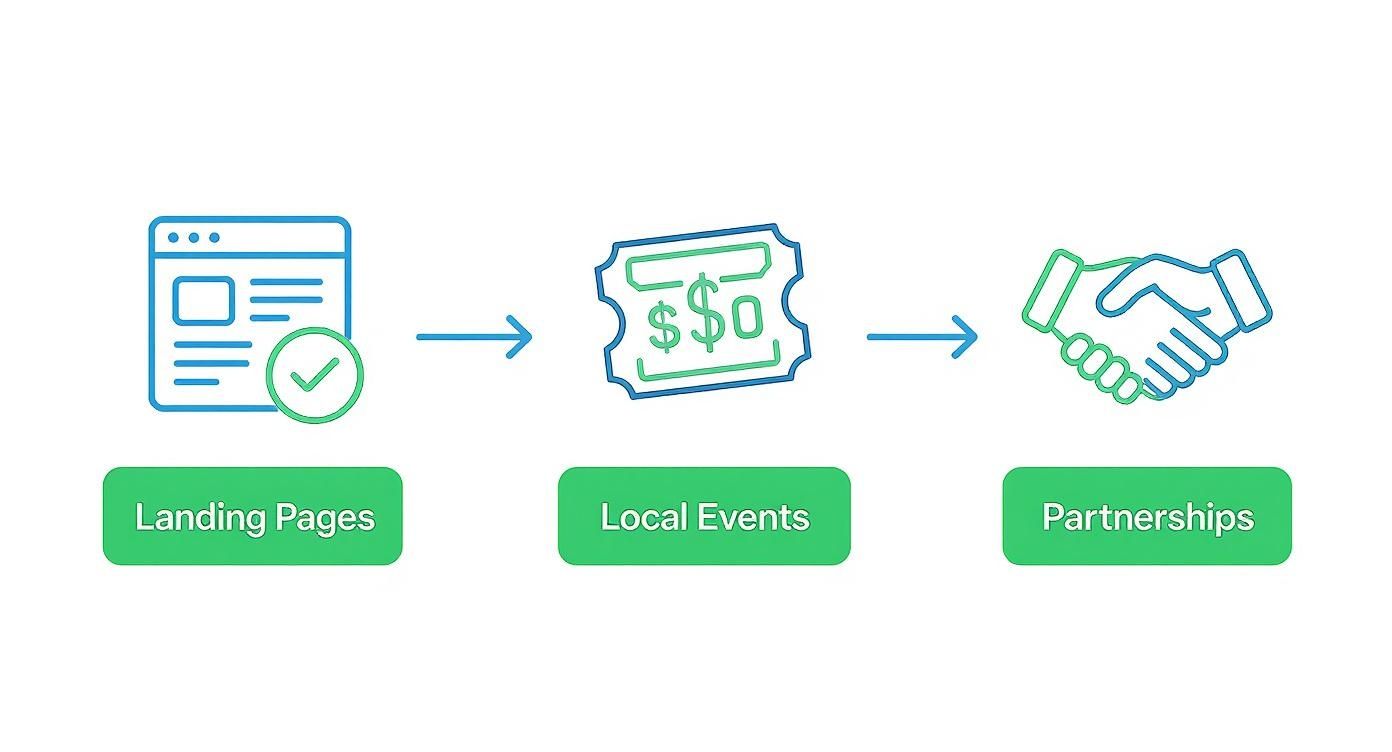
As you can see, a successful local strategy relies on multiple touchpoints that reinforce each other, building a strong, unshakeable community presence.
The Low-Cost, High-Impact Toolkit
You don't need an enterprise-level budget to get your hands on powerful marketing tools. These days, a handful of affordable (and even free) platforms can do the heavy lifting, letting you execute your strategy with a professional touch. The goal here is to automate, organize, and amplify your efforts without wasting a minute.
The best tools are the ones that save you your most valuable resource: time. A small monthly subscription that gives you back hours of manual work is one of the best investments you can possibly make.
Here's a curated stack that's perfect for a lean operation:
- Project Management: Keep your entire strategy organized in one place. A flexible tool like Notion lets you build a custom marketing dashboard, while a more focused app like todoist is perfect for managing your weekly and monthly checklists with clear deadlines.
- Email Marketing: As I mentioned, Brevo offers a generous free plan that includes email campaigns, automation, and landing pages. It’s ideal for nurturing your local audience without an upfront cost.
- Social Media Management: To escape the daily grind of posting, SocialBee helps you create content categories and schedule posts far in advance, ensuring your social channels stay consistently active.
This simple toolkit covers your core needs—organization, communication, and social presence. By choosing tools that are powerful yet easy to use, you can build a professional marketing system that runs smoothly in the background, freeing you up to focus on what really matters: serving your local customers.
Measuring the Metrics That Actually Matter
You can't improve what you don't measure. A local marketing strategy without clear data is just guesswork, and nobody has time for that. This is where we cut through the noise of vanity metrics and get down to what actually tells you if your efforts are working.
Forget about numbers that look good but don't mean anything for your bottom line. We're zeroing in on the key performance indicators (KPIs) that connect directly to leads, sales, and real business growth.
The goal here isn't to build some ridiculously complicated analytics dashboard that requires a data science degree. It's to create a simple, sustainable system for keeping an eye on performance. The best part? You can do this with free tools you probably already use: Google Analytics, Google Search Console, and your Google Business Profile Insights.
This approach lets you make smart, data-driven decisions, double down on what’s actually bringing in customers, and continuously tweak your strategy for better results.
Moving Beyond Vanity Metrics
It's so easy to get caught up in numbers that feel impressive but don't move the needle. Things like social media followers or total website pageviews can be a trap. For a local business, the metrics that really matter are the ones that signal a potential customer is taking a meaningful step toward pulling out their wallet.
A perfect example of this is how you look at your Google Business Profile (GBP) performance. Impressions—the number of times your profile was seen—are interesting, sure. But actions are what pay the bills.
The most critical shift you can make in your local marketing analytics is moving from asking "How many people saw us?" to "How many people did something because they saw us?" A single phone call from your GBP listing is infinitely more valuable than a thousand passive impressions.
The key is to track the direct user engagements that show high purchase intent. These are the clicks, calls, and direction requests that fill your pipeline and grow your revenue.
Your Core Local Marketing KPIs
To get a clear picture of your performance, you only need to focus on a handful of high-impact KPIs. Together, these metrics tell the complete story, from someone discovering you in a local search to becoming a confirmed lead or sale. By checking in on these consistently, you'll know exactly which parts of your local strategy are giving you the best bang for your buck.
Here’s a quick look at the essential local marketing KPIs you should be tracking, what they actually mean for your business, and the tools you'll use to find them.
Essential Local Marketing KPIs and Their Meanings
| KPI | What It Measures | Tool to Track |
|---|---|---|
| GBP Actions | The number of direct interactions from your profile, such as phone calls, website clicks, and requests for directions. | Google Business Profile Insights |
| Local Keyword Rankings | Your visibility in search results for key terms like "[your service] near me" or "[your product] in [your city]." | Google Search Console (Performance Report) |
| Local Organic Traffic | The number of visitors who find your website through non-paid, location-based search results. | Google Analytics (Acquisition Report) |
| Geo-Located Conversions | The volume of leads or sales specifically coming from users within your target geographic area. | Google Analytics (Audience > Geo Report) |
By keeping an eye on these specific metrics, you're not just collecting data—you're gathering intelligence that helps you make smarter decisions about where to invest your time and money.
Building Your Monthly Dashboard
Your monthly performance dashboard doesn't need to be fancy. A simple spreadsheet or a page in a tool like Notion is all you need. Just log these key numbers at the end of each month. This little ritual takes less than an hour but gives you incredible clarity on what's happening.
Here’s a simple process to get you started:
- Pull GBP Data: Hop into your Google Business Profile and jot down the total number of website clicks, direction requests, and phone calls for the past month.
- Check Search Console: In Google Search Console, look at your top local queries. Note your average ranking position for your most important keywords. Are you moving up or down?
- Analyze Google Analytics: Filter your traffic by organic search and check the "Landing Page" report. This shows you which of your local pages are bringing people in. Cross-reference this with your geographic data to see where your best customers are physically located.
Tracking these KPIs month-over-month is how you spot trends, uncover opportunities, and gain the confidence to put your limited resources into the channels that truly move the needle for your business.
Your Top Local Marketing Questions, Answered
Jumping into local marketing always kicks up a few questions. I get it. To cut through the noise, here are some straight-up answers to the most common things business owners ask, giving you the practical advice you need to get moving.
"So, How Long Does Local SEO Actually Take?"
This is always one of the first questions, and the honest answer is: it’s a long game. Unlike a paid ad that gets you instant visibility, local SEO is an investment. You might notice some small wins within a few weeks, but for the big stuff—like consistently landing in the Google Local Pack—you're looking at three to six months of steady, focused work.
Of course, that timeline isn't set in stone. It really depends on a few things:
- Your Competition: If you're in a packed downtown area, you've got more ground to cover to outrank the established players.
- Your Starting Line: A brand-new, unoptimized Google Business Profile with zero reviews has a steeper hill to climb than one that's been around a while.
- Your Consistency: This is the big one. Regularly updating your profile, getting a steady stream of new reviews, and building local citations is what builds momentum.
Think of it like tending a garden. You don’t plant seeds and get a harvest the next day. But with consistent watering and care, you build something strong that pays off for years to come.
"What’s the Best Way to Handle Negative Reviews?"
Getting a bad review stings. It can feel like a personal attack. But how you respond is public, and a great response can actually win over future customers who are watching from the sidelines. The key is to be quick, professional, and empathetic. Whatever you do, don't get dragged into a public fight.
A solid response follows a simple framework:
- Acknowledge Their Frustration: Start by thanking them for the feedback and saying you're sorry their experience wasn't what it should have been.
- Own It (Without Excuses): "We're sorry to hear the service was slower than usual" lands a lot better than, "We were swamped that night."
- Offer a Fix: Give them a direct path to a resolution, taking the conversation offline. Something like, "Please email our manager at [email] so we can make this right for you," works perfectly.
A well-handled negative review can be more powerful than a dozen positive ones. It shows potential customers that you're a business that listens, cares, and is committed to fixing things when they go wrong.
"If I Can Only Do One Thing First, What Should It Be?"
Feeling overwhelmed? If you're just starting out and need the biggest bang for your buck, focus on one thing: fully claiming and optimizing your Google Business Profile (GBP). This is your digital storefront, your billboard, and your welcome mat all rolled into one. It is, without a doubt, the most critical asset in your local marketing arsenal.
A complete GBP isn't optional. It's the primary source of information for Google Search and Google Maps, which is exactly how the vast majority of your local customers are going to find you. Before you spend a single dollar on ads or an hour on social media, make sure every last section of your GBP is filled out with accurate, compelling, and current information.
This single move puts you on the map—literally. It’s the foundation for everything else you'll do, and it's the highest-leverage first step you can possibly take.


